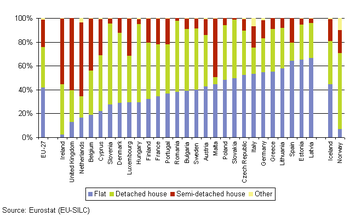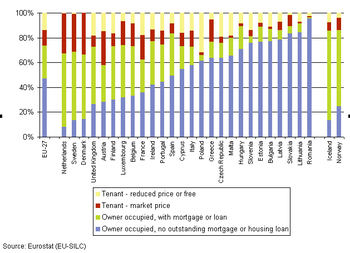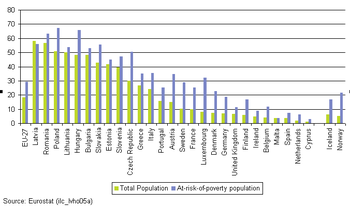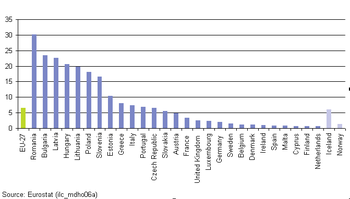Archive:Housing statistics
- Data from July 2010, most recent data: Further Eurostat information, Database.
Decent and affordable housing is a fundamental need and right. Ensuring this need is still a significant challenge in a number of European Union (EU) countries. Decent housing, at an affordable price in a safe environment is likely to alleviate poverty and social exclusion.
Main statistical findings
Type of dwelling
In 2008, 42 % of EU population lived in flats, 34 % in detached houses and 23 % in semi-detached houses. The share of persons living in flats was highest in Latvia (67 %), Estonia (65 %) and Spain (64 %). The percentage of people living in detached houses was largest in Slovenia (68 %), Hungary (65 %), Romania (60 %) and Denmark (59 %). The highest percentages of people living in semi-detached houses were reported in the Netherlands (62 %), the United Kingdom (61 %) and Ireland (55 %) (see: Graph 1.)
Tenure status
In 2008, 74 % of the population in the EU owned their home of which 27 % had to pay mortgage. 12 % paid rent at market price and 14 % paid a reduced-rate rent or occupied free accommodation. In all countries half or more than half of the population owned their dwelling. The figures ranged from 58 % in Austria to 96 % in Romania. Among the owners the highest proportion of those paying a mortgage was in Sweden, the Netherlands, Iceland and Norway (56 %, 60 %, 62 % and 72 % respectively). As for the persons paying a rent at market price figures did not exceed 10 % in 14 Member States and Iceland while in Sweden, the Netherlands and Denmark more than 30 % of population was paying rent at market price. The share of the population paying a rent at reduced price or occupying an accommodation free of charge exceeded 15 % in only 7 countries (Cyprus, Finland, France, the United Kingdom, Malta, the Czech Republic and Poland). (see: Graph 2.)
Housing quality
One of the key dimensions in assessing the quality of housing conditions is the availability of sufficient space in the dwelling. The overcrowding rate describes the percentage of people living in a dwelling considered as overcrowded. Based on the number of rooms available to the household, this indicator depends on the household's size, as well as its members' ages and family situation.
In 2008, 18 % of the EU population lived in overcrowded dwellings. The highest percentages of persons living in overcrowded dwellings were registered in Latvia (58 %), Romania (57 %), Poland (51 %) and Lithuania (50 %). By contrast, Cyprus (1 %) and the Netherlands (2 %) recorded the lowest percentage. With a rate of 29 % in the EU-27 the at-risk-of-poverty population (whose equivalised income is below 60 % of median equivalised income) lived more often in overcrowded dwellings. The highest percentages of persons living in overcrowded dwellings among the at-risk-of-poverty population were registered in Poland (67 %), Hungary (66 %) and Romania (63 %), on the contrary less than 5 % in Cyprus and Malta. (see: Graph 3.)
In addition to overcrowding some aspects such as the lack of bath and toilet, leaking roof in dwelling or too dark dwelling are taken into account to build a more complete indicator of housing quality. This indicator named ‘Severe housing deprivation rate’ is defined as the share of persons living in the dwelling which is considered as overcrowded, while also exhibiting at least one of the housing deprivation measures. (see: Graph 4.)
At EU level 7 % of the population suffered from severe housing deprivation. In Hungary, Latvia, Bulgaria and Romania more than 20 % of the population faced severe housing deprivation in 2008. By contrast, less then 1 % of the population in the Netherlands, Cyprus, Finland, Spain and Malta lived in severe housing deprivation.
Housing affordability
In the EU in 2008, 12.4 % of EU citizens spent 40 % or more of their equivalised disposable income on housing. This average masks significant differences between Member States. At one extreme there are countries with a small percentage of the population whose housing cost exceeds 40 % of their disposable income such as Cyprus (2.0 %) Ireland (3.6 %), Estonia, Luxembourg (3.7 %) and Malta (3.8 %). At the other extreme, this share was around 19 % in Romania and 17 % in the United Kingdom. The highest value was reached in Germany with 26.0 %. In almost all countries the percentages of the population whose housing costs exceeded 40 % of their equivalised disposable income were the highest for tenants paying market price (except Slovenia) and the lowest for owners without mortgage payments (except Iceland). (see: Table 1.)
Data sources and availability
The data used in this section are primarily derived from micro-data from EU statistics on income and living conditions (EU-SILC) . The reference population is all private households and their current members residing in the territory of the Member State at the time of data collection; persons living in collective households and in institutions are generally excluded from the target population.
Definitions
A Glossary:Collective household is defined in terms of shared household expenses. If household expenses are not shared, then the person(s) constitute separate household(s) at the same address. A household may comprise either one person living alone or a group of people, not necessarily related, living at the same address with common housekeeping. The average number of persons per private household is the number of persons living in private households divided by the number of private households; collective households such as boarding houses, halls of residence and hospitals and the persons living in them are excluded.
Households are considered as overcrowded if the dwelling in which they live does not comprise a minimum number of rooms, established upon the basis of: one room for the household; one room for each couple; one room for each single person aged 18 or more; one room for two single people of the same sex between 12 and 17 years of age; one room for each single person of a different sex between 12 and 17 years of age; and one room for two people under 12 years of age.
Housing deprivation is a measure of poor amenities and is calculated by referring to those households with a leaking roof, no bath/shower and no indoor toilet, or a dwelling that is considered too dark. Severe housing deprivation is defined as households that are overcrowded, while also exhibiting at least one of the housing deprivation measures.
Context
Questions of social housing, homelessness or integration play an important role within the social policy agenda. The charter of fundamental rights stipulates in Article II-94 that ‘in order to combat social exclusion and poverty, the Union recognises and respects the right to social and housing assistance so as to ensure a decent existence for all those who lack sufficient resources, in accordance with Community law and national laws and practices’.
However, the EU does not have any responsibilities in respect of housing; rather, national governments have the duty to develop their own housing policies. Many countries face similar challenges: for example, how to renew housing stocks, how to plan and combat urban sprawl, how to promote sustainable development, how to help young and disadvantage groups to get on the housing ladder, or how to promote energy efficiency among house-owners.
Further Eurostat information
Publication
The social situation in the European Union 2009
Combating poverty and social exclusion
Database
- Income and living conditions (ilc) Housing conditions
Dedicated section
- Household Budget Surveys
- Income, Social Inclusion and Living Conditions
Other information
- The continuity of indicators during the transition between ECHP and EU-SILC
- The production of data on homelessness and housing deprivation in the European Union: survey and proposals
- Regulation 1177/2003 of 16 June 2003 concerning Community statistics on income and living conditions (EU-SILC)
- Regulation 1553/2005 of 7 September 2005 amending Regulation 1177/2003 concerning Community statistics on income and living conditions (EU-SILC)
- Regulation 1791/2006 of 20 November 2006 adapting certain Regulations and Decisions in the fields of ... statistics, ..., by reason of the accession of Bulgaria and Romania




